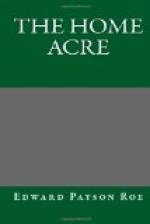Possibly at the time of purchase the acre may be covered with coarse grass, weeds, or undergrowth of some kind. In this case, after the initial plowing, the cultivation for a season of some such crop as corn or potatoes may be of great advantage in clearing the land, and the proceeds of the crop would partially meet expenses. If the aim is merely to subdue and clean the land as quickly as possible, nothing is better than buckwheat, sown thickly and plowed under just as it comes into blossom. It is the nature of this rampart-growing grain to kill out everything else and leave the soil light and mellow. If the ground is encumbered with many stones and rocks, the question of clearing it is more complicated. They can be used, and often sold to advantage, for building purposes. In some instances I have seen laboring-men clear the most unpromising plots of ground by burying all rocks and stones deeply beneath the surface—men, too, who had no other time for the task except the brief hours before and after their daily toil.
I shall give no distinct plan for laying out the ground. The taste of the owner, or more probably that of his wife, will now come into play. Their ideas also will be modified by many local circumstances—as, for instance, the undulations of the land, if there are any; proximity to neighbors, etc. If little besides shade and lawn is desired, this fact will have a controlling influence; if, on the other hand, the proprietor wishes to make his acre as productive as possible, the house will be built nearer the street, wider open space will be left for the garden, and fruit-trees will predominate over those grown merely for shade and beauty. There are few who would




